|
|
 |
Fiche d'espèce de Copépode |
|
|
Calanoida ( Ordre ) |
|
|
|
Lucicutiidae ( Famille ) |
|
|
|
Lucicutia ( Genre ) |
|
|
| |
Lucicutia gaussae Grice, 1963 (F,M) | |
| | | | | | | Syn.: | Lucicutia ovalis Wolfenden, 1906 (p.28, figs.F); 1911 (p.319, figs.F); Farran, 1926 (p.277, Rem.); 1929 (p.209, 263, fig.M); Sewell, 1932 (p.290); Farran, 1936 a (p.112); Mori, 1937 (1964) (p.72, figs.F), Rose, 1933 a (p.197, figs.F); Sewell, 1948 (p.323, 503, 521, 547, 558); C.B. Wilson, 1950 (p.256); Tanaka, 1953 (p.134); Hoenigman, 1955 (p.49); Vervoort, 1957 (p.126); Grice, 1962 (p.222, figs.F); Ganapati & Shanthakumari, 1962 (p.8, 15); Gaudy, 1962 (p.111); Tanaka, 1963 (p.27, Rem.F,M); V.N. Greze, 1963 a (tabl.2); Giron-Reguer, 1963 (p.51); Unterüberbacher, 1964 (p.29); De Decker & Mombeck, 1964 (p.13); Tanaka, 1965 a (p.19); Chen & Zhang, 1965 (p.84, figs.F,M); Vervoort, 1965 (p.114, Rem.); El-Maghraby, 1965 (p.54, Appendix); Furuhashi, 1966 a (p.295, vertical distribution in Kuroshio region, Table 9); Mazza, 1966 (p.71); Pavlova, 1966 (p.44); Delalo, 1968 (p.138); Berdugo & Kimor, 1968 (p.448); Hure & Scotto di Carlo, 1968 (p.27); Bainbridge, 1972 (p.61, Appendix Table II, vertical distribution %); Hure & al., 1980 (298); Campos, 1982 (p.13); Kovalev & Shmeleva, 1982 (p.84); Guangshan & Honglin, 1984 (p.118, tab.); Brenning, 1985 a (p.28, Table 2); Regner, 1985 (p.11, Rem.: p.36); Lozano Soldevilla & al., 1988 (p.59); Shih & Young, 1995 (p.70); Vukanic, 2003 (139, tab.1); Mageed, 2006 (p.171, Table 4, as ovales) | | | | Ref.: | | | Grice, 1963 a (p.498, Rem.); Hülsemann, 1966 (p.715, figs.F,M); Vidal, 1968 (p.39, figs.F); Corral Estrada, 1970 (p.187, figs.M); Park, 1970 (p.477); Deevey, 1971 (p.224); Björnberg & al., 1981 (p.648, figs.F,M); Ali-Khan & Ali-Khan, 1982 (p.267, figs.F,M); Chihara & Murano, 1997 (p.829, tab.5, Pl.123: F,M); Bradford-Grieve & al., 1999 (p.883, 945, figs.F,M); Barthélémy, 1999 a (p.8Boxshall & Halsey, 2004 (p.133: F; p.135: M); Vives & Shmeleva, 2007 (p.333, figs.F,M, Rem.) | 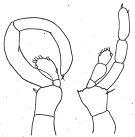 issued from : G.P. Farran in British Antarctic (\"Terra Nova\") Expedition, 1910. Natural History Reports. Zoology. Vol. VIII. Crustacea, 1929. [p.263, Fig.25]. As Lucicutia ovalis. Male: fith feet
|
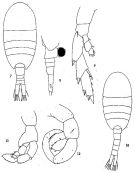 &issued from: Q.-c Chen S.-z. Zhang in Studia Marina Sinica, 1965, 7. [Pl.33, 7-12]. As Lucicutia ovalis. Female (from E China Sea): 7, habitus (dorsal); 8, urosome (lateral right side); 9, left P5 (posterior). Male: 10, habitus (dorsal); 11, left P5 (anterior); 12, right P5 (posterior).
|
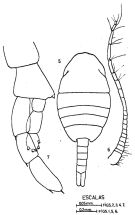 issued from : J. Corral Estrada in Tesis Doct., Univ. Madrid, A-129, Sec. Biologicas, 1970. [Lam.49, figs.5-7]. Male (from Canarias Is.): 5, habitus (dorsal); 6, left A1; 7, left P5.
|
 Issued from : K. Hülsemann in Bull. Mar. Sc., 1966, 16 (4). [p.722, Figs.92-93]. Female: 92, genital segment (lateral left side); 93, habitus (dorsal).
|
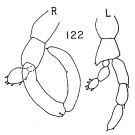 Issued from : K. Hülsemann in Bull. Mar. Sc., 1966, 16 (4). [p.728, Fig.122]. Male: 122, P5.
|
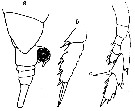 issued from : R.N. Wolfenden in Die Marinen Copepoden der Deutschen Südpolar-Expedition 1901-1903, 1911. [p.319, Fig.61]. As Lucicutia ovalis. Female: a, posterior part cephalothorax and urosome; b, exopod segments of P4; c, P5.
|
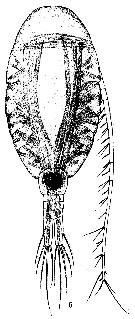 issued from : R.N. Wolfenden in Die Marinen Copepoden der Deutschen Südpolar-Expedition 1901-1903, 1911. [Pl.XXXV, Fig.6]. As Lucicutia ovalis. Female: 6, habitus (dorsal).
|
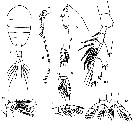 issued from : T. Mori in The pelagic Copepoda from the neighbouring waters of Japan, 1937 (1964). [Pl.36, Figs.6-13]. As .
Female: 6, A1; 7, habitus (dorsal); 8, P1; 9, P2; 10, P5; 11, A2; 12, P3; 13, P4.
|
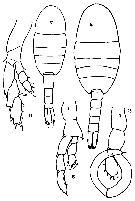 issued from : S. Ali-Khan & J. Ali-Khan in Crustaceana, 1982, 43 (3). [p;267, Figs.14-18]. Male (from 24°09'N, 64°27'E): 14, habitus (dorsal); 15, right P5; 16, left P5. Nota: The inner marginal process of the 2nd basal segment of P5 agrees with the figure given by Hulsemann (1966) but the outer margin differs by having 1 seta in our specimenn Female: 17, habitus (dorsal); 18, P5.
|
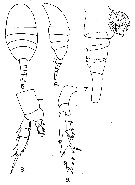 issued from : G.D. Grice in Fish. Bull. Fish and Wildl. Ser., 1962, 61. [p.221, Pl.24, Figs.5-9]. As Lucicutia ovalis Wolfenden, 1911. Female (from equatorial Pacific): 5-6, habitus (dorsal and lateral, respectively); 7, urosome (lateral, right side); 8, P1; 9, P5.
|
 issued from : R.-M. Barthélémy in These Doc. Univ. Provence (Aix-Marseille I), 1999. [Fig.17]. Female: C, external ventral view genital double-somite; gp = gonoporal plate; opercular pad arrowed.
|
 Lucicutia gaussae Lucicutia gaussae female: 1 - Characters following not combined : Prosome about 3 times longer than urosome. Cephalosome with slightly projecting and rounded anterior corners and well developed lateral spinous projections; anal somite about as long as wide; caudal rami 11.7 times longer than wide and bowed outwards at base, leaving elliptical space between rami proximally. 2 - P1 with 2-segmented endopod. 3 - Cephalosome not with 2 pairs of lateral spinous projections, but with other forms. 4 - A1 extending to end of caudal ramus or 1 to 2 segments beyond. 5 - Caudal rami 3 to 4 times longer than wide. 6 - Terminal setal element of P5 very short, less than 1/3 lenght of 3rd exopodal segment. 7 - A1 extending 2 segments beyond tip of caudal ramus; anal somite shorter than preceding somite; cephalosome with strong evenly rounded.
|
 Lucicutia gaussae Lucicutia gaussae male: 1 - P1 with 2-segmented endopod; 2 - Caudal rami less than 10 times longer than wide. 3 - Inner distal corner of basis of P5 without strong spine. 4 - Basis of left P5 ornamented differently from L. oblonga. 5 - Caudal rami about 3 to 5 times longer than wide. 6 - A1 at most reaching to end of caudal rami; basis of left P5 different from L. longiserrata. 7 - Cephalosome smoothly rounded (in dorsal view); right A1 reaching beyond tip of caudal rami; inner margin of basis of right P5 smooth; inner distal corner of basis of left leg ending in single point.
| | | | | Ref. compl.: | | | Grice & Hulsemann, 1965 (p.224); 1967 (p.17); Fleminger, 1967 a (tabl.1); Roe, 1972 (p.277, tabl.1, tabl.2); Heinrich, 1973 (p.95); Corral Estrada & Pereiro Muñoz, 1974 (tab.I); Deevey & Brooks, 1977 (p.256, tab.2, Station "S"); Carter, 1977 (1978) (p.36); Bowman, 1977 (p.695, Rem.: parasite); Dessier, 1979 (p.206); Vives, 1982 (p.293); De Decker, 1984 (p.317); Cummings, 1984 (p.163, Table 2); Brinton & al., 1986 (p.228, Table 1); Lozano Soldevilla & al., 1988 (p.59); Padmavati & al., 1998 (p.349); Suarez-Morales & Gasca, 1998 a (p.110); Lopez-Salgado & al., 2000 (tab.1); Uysal & al., 2002 (p.17, tab.1); Hsiao & al., 2004 (p.326, tab.1); Hsieh & al., 2004 (p.397, tab.1); Rezai & al., 2004 (p.490, tab.2, p.495, tab.8); Lo & al., 2004 (p.89, tab.1); Kazmi, 2004 (p.228); Koppelmann & Weikert, 2007 (p.266: tab.3); Dur & al., 2007 (p.197, Table IV); McKinnon & al., 2008 (p.844: Table.1); Ayon & al., 2008 (p.238, Table 4: Peruvian samples); Cornils & al., 2010 (p.2076, Table 3); Schnack-Schiel & al., 2010 (p.2064, Table 2: E Atlantic subtropical/tropical); Dias & al., 2010 (p.230, Table 1); Mazzocchi & Di Capua, 2010 (p.426); Medellin-Mora & Navas S., 2010 (p.265, Tab. 2); Fazeli & al., 2010 (p.153, Table 1); Hsiao S.H. & al., 2011 (p.475, Appendix I); Uysal & Shmeleva, 2012 (p.909, Table I); in CalCOFI regional list (MDO, Nov. 2013; M. Ohman, comm. pers.); Bonecker & a., 2014 (p.445, Table II: frequency, horizontal & vertical distributions); Benedetti & al., 2016 (p.159, Table I, fig.1, functional characters); Belmonte, 2018 (p.273, Table I: Italian zones) | | | | NZ: | 17 | | |
|
Carte de distribution de Lucicutia gaussae par zones géographiques
|
| | | | | | | | | | | | | Loc: | | | South Africa (E & W), Namibia, off N St. Helena Is., S Brazil, off Rio de Janeiro, off Macaé, Congo, G. of Guinea, off Lagos, off S Cape Verde Is., off Morocco-Mauritania, Canary Is., off Amazon, Caribbean Sea, Caribbean Colombia, G. of Mexico, Cuba, Florida, Sargasso Sea, off Bermuda (Station "S"), Cape Hatteras, Bay of Biscay, Ibero-moroccan Bay, Medit. (Alboran Sea, W Basin, Ligurian Sea, Tyrrhenian Sea, Adriatic Sea, Mljet Is., Ionian Sea, Aefean Sea, Lebanon Basin, Egypt coast), Red Sea, Gulf of Oman, G. of Aden, Arabian Sea, Natal, Indian, India (Lawson's Bay), Australia (North West Cape), Straits of Malacca, Indonesia (SW Celebes), Philippines, China Seas (East China Sea, South China Sea), Taiwan (SW, E, W, N: Mienhua Canyon), Japan, California, Gulf of California, Pacif. (W equatorial), Australia (Great Barrier), off New Zealand, Pacif. (equatorial), Peru, N Chile | | | | N: | 69 | | | | Lg.: | | | (10) F: 1,5-1,25; (16) F: 1,36; (21) F: 1,5-1,1; M: 1,4-1,2; (26) F: 1,49-1,42; M: 1,37; (34) F: 1,41-1,25; M: 1,21; (35) F: 1,56-1,38; M: 1,38-1,32; (38) F: 1,6-1,4; (101) F: 1,46-1,32; (187) F: 1,4; (199) F: 1,44-1,29; M: 1,37-1,22; (290) F: 1,4-1,6; M: 1,4-1,5; (402) F: 1,36-1,3; M: 1,32-1,29; {F: 1,10-1,60; M: 1,20-1,50}
| | | | Rem.: | épi & mésopélagique.
Il n'est pas tenu compte des localisations dont les espèces citées ne sont pas suivies du nom du descripteur.
Voir aussi les remarques en anglais | | | Dernière mise à jour : 05/02/2020 | |
|
|
 Toute utilisation de ce site pour une publication sera mentionnée avec la référence suivante : Toute utilisation de ce site pour une publication sera mentionnée avec la référence suivante :
Razouls C., Desreumaux N., Kouwenberg J. et de Bovée F., 2005-2025. - Biodiversité des Copépodes planctoniques marins (morphologie, répartition géographique et données biologiques). Sorbonne Université, CNRS. Disponible sur http://copepodes.obs-banyuls.fr [Accédé le 31 décembre 2025] © copyright 2005-2025 Sorbonne Université, CNRS
|
|
 |
 |














